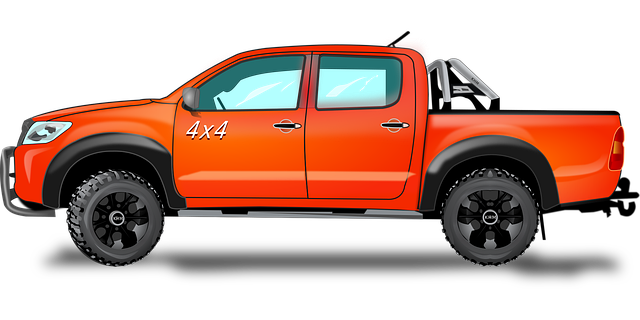4×4 off-road vehicles require an intricate understanding of their drivetrain and suspension systems for optimal performance on varied terrains. The robust drivetrain evenly or selectively distributes power to all four wheels for superior traction, while the suspension system maintains tire contact for optimal grip over uneven surfaces. A sturdy chassis is crucial for safety amidst the rigors of off-roading, and protective measures like underbody protection shield against impacts and debris. Mastering 4WD off-road driving techniques is not just about skillful maneuvering but also includes preemptive mechanical checks to ensure vehicle integrity and reliability. Routine vehicle inspections are essential for identifying potential issues in drivetrain components, suspension systems, tires, and brakes before they escalate during an off-road adventure.
Off-road enthusiasts must diligently maintain their vehicles' differentials and suspension systems to handle diverse terrains with precision. Regular servicing of differentials and fine-tuning of the suspension system are key to preventing wear and tear, ensuring control, and maintaining vehicle integrity. By mastering 4WD off-road driving techniques and regularly practicing low-speed maneuvers, drivers can understand their vehicle's dynamics better, leading to improved safety, efficiency, and performance in challenging conditions.
Additionally, the specialized electrical systems of off-road vehicles must be meticulously maintained to withstand harsh environmental conditions. Regular checks on critical components like the battery, alternator, starter, wiring harnesses, and lighting systems are necessary to ensure reliability and safety. A systematic approach to diagnosing electrical issues is essential, with technicians utilizing specialized tools for precise problem identification and care. By adopting a proactive stance on electrical system maintenance, technicians can enhance the lifespan of off-road vehicles and bolster drivers' confidence in mastering 4WD off-road driving techniques across all types of terrain.
4×4 off-road enthusiasts and adventurers know that a vehicle’s reliability and performance can make or break a journey. This article delves into the critical aspects of maintaining and diagnosing your off-road vehicle, ensuring you conquer technical terrains with confidence. From understanding the intricate components of a 4WD off-road vehicle to the meticulous pre-trip inspection, we cover it all. We’ll explore the vital role of differentials and suspension systems in tackling rugged landscapes. Additionally, mastering 4WD off-roading techniques for maximizing traction and control is paramount, a subject we’ll address in depth. Finally, maintaining and diagnosing your vehicle’s electrical systems will be highlighted as an integral part of off-road preparedness. Embark on this journey to transform your off-road experience with our comprehensive guide.
- Understanding the Components of a 4WD Off-Road Vehicle
- Pre-Trip Inspection: Ensuring Safety and Reliability
- Tackling Technical Terrains: Differential and Suspension Systems
- Mastering 4WD Techniques for Maximizing Traction and Control
- Diagnosis and Maintenance of Electrical Systems in Off-Road Vehicles
Understanding the Components of a 4WD Off-Road Vehicle

4×4 off-road vehicles are intricate machines designed to traverse challenging terrains with precision and durability. Mastering the components that constitute a 4WD off-road vehicle is crucial for both maintenance and performance optimization. The drivetrain, which includes the transfer case, front and rear differentials, and drive shafts, is at the heart of a 4WD system. It distributes power evenly or differentially to all four wheels, providing traction on varied surfaces. The suspension system, with its coil springs, shock absorbers, and control arms, plays a vital role in handling the uneven terrain by maintaining tire contact for optimal grip. The chassis must be robust to handle the stress of off-roading without compromising the safety of the vehicle or its occupants. Additionally, the vehicle’s underbody protection, skid plates, and robust tires are designed to withstand impacts and debris. Understanding these components allows off-road enthusiasts to diagnose potential issues before they become critical during a rugged expedition. Proper maintenance of each part ensures that the 4WD off-road vehicle can navigate through challenging landscapes efficiently, making the experience both safe and enjoyable. By familiarizing oneself with the anatomy of a 4WD off-road vehicle, one can better master the techniques required for off-roading, enhancing their ability to conquer difficult trails and environments.
Pre-Trip Inspection: Ensuring Safety and Reliability

Before embarking on off-road expeditions, a thorough pre-trip inspection is pivotal to ensure the safety and reliability of your four-wheel drive (4WD) vehicle. Mastery of 4WD off-roading techniques is not just about skillful maneuvering; it also encompasses the ability to anticipate and mitigate potential mechanical issues that could arise on rugged terrains. During this inspection, attention must be given to the vehicle’s critical components, such as the drivetrain, suspension system, tires, and brakes. Each element is subjected to a rigorous check: drivetrain components like transfer case, front differential, and rear differential are scrutinized for leaks or damage that could impede power distribution to all four wheels. The suspension system’s integrity, including shocks, springs, mounts, and bushings, should be assessed for wear or breakage that might compromise handling on uneven surfaces. Tires must be inspected for proper inflation, tread depth, and overall condition; they are the only contact with the unforgiving ground you’ll traverse. Lastly, brakes should be evaluated for responsiveness and effectiveness, as they are your lifeline in bringing the vehicle to a halt under challenging conditions. By meticulously going through these checks, off-road enthusiasts can enhance their confidence and safety, ensuring that their 4WD vehicle is prepared to handle the demands of off-roading terrain. This level of preparation is essential for mastering 4WD off-roading techniques and for returning safely from every journey.
Tackling Technical Terrains: Differential and Suspension Systems

4WD off-road enthusiasts understand that the success of navigating technical terrains hinges on two critical components: the differential and suspension systems. These systems work in tandem to ensure optimal traction and stability across challenging terrains. Mastering 4WD off-road techniques begins with a thorough inspection and diagnosis of the vehicle’s differentials, which distribute power to individual wheels, providing the necessary torque for climbing over obstacles or maneuvering through loose surfaces. Regular servicing and maintenance of the differential are crucial to prevent failure under strain, which can lead to a loss of drive or unexpected wheel spin.
In parallel, the suspension system must be finely tuned to handle the rigors of off-road driving. It absorbs shocks and impacts from rough terrain, maintaining vehicle control and occupant comfort. A robust suspension setup not only enhances the vehicle’s ability to traverse diverse terrains but also protects critical components from damage. When inspecting the suspension, one must look for signs of wear, such as broken springs or bushings, and ensure that all joints are tight and lubricated. Proper alignment and balance post-inspection are vital to prevent premature tire wear and guarantee the safety and performance of the vehicle on technical trails. By mastering 4WD off-road techniques in conjunction with maintaining these essential systems, off-roaders can confidently tackle the most demanding terrains with precision and control.
Mastering 4WD Techniques for Maximizing Traction and Control

4WD off-road vehicles offer an unparalleled experience for traversing rugged terrains, but to fully harness their potential and ensure safety and efficiency, it’s crucial to master the techniques specific to four-wheel drive systems. Effective management of traction and control is paramount when venturing off-road; drivers must understand how each terrain type affects vehicle behavior and respond accordingly. Drivers can enhance their 4WD off-roading skills by practicing low-speed maneuvers that teach vehicle dynamics, such as throttle control, gear selection, and steering techniques that optimize traction. Additionally, learning the proper use of differential lockers, when applicable, can provide extra grip on particularly challenging surfaces like mud, sand, or rocks. By familiarizing oneself with these 4WD off-road techniques, drivers can navigate through diverse landscapes confidently and competently, making the most of their vehicle’s capabilities to conquer any obstacle they may encounter. Regular practice and an understanding of the vehicle’s mechanisms will lead to a harmonious relationship between driver and machine, ensuring a successful and controlled off-road adventure.
Diagnosis and Maintenance of Electrical Systems in Off-Road Vehicles

Off-road vehicles, particularly those equipped with four-wheel drive (4WD), encounter unique electrical system challenges due to the demanding conditions they often navigate. These vehicles are subjected to dust, moisture, and vibration, which can lead to premature wear or failure of electrical components. Regular inspection and maintenance of the electrical systems are paramount for ensuring the reliability and safety of off-road vehicles. Technicians skilled in mastering 4WD off-roading techniques understand that preventive measures are crucial in maintaining an off-road vehicle’s electrical integrity. They perform routine checks on all critical components, including the battery, alternator, starter, wiring harnesses, and lighting systems. The battery, for instance, should be securely mounted to prevent movement that could cause internal damage. Additionally, connections should be cleaned, insulated, and tightened to prevent corrosion and ensure optimal performance.
Diagnosing electrical issues in off-road vehicles requires a systematic approach. When a problem arises, it’s essential to trace the issue back to its source by checking fuses, relays, and switches first. This methodical process helps isolate the fault, whether it be in the power distribution circuit or within individual components like the battery or alternator. Utilizing specialized diagnostic equipment, such as multimeters and oscilloscopes, allows technicians to mastering 4WD off-roading techniques to pinpoint electrical anomalies with precision. Regular servicing of the vehicle’s charging system is also critical, as it ensures that the battery remains charged, and the alternator operates efficiently. This proactive approach to maintaining the electrical systems of off-road vehicles not only extends their lifespan but also enhances the driver’s confidence when tackling rugged terrains.
4WD off-road vehicles are intricate machines requiring meticulous care and expertise to navigate challenging terrains effectively. This article has delved into the critical components of these vehicles, emphasizing the importance of a thorough pre-trip inspection to guarantee safety and reliability. We’ve explored the differential and suspension systems vital for tackling technical terrain, and the essential 4WD techniques that enhance traction and control. Additionally, maintaining the vehicle’s electrical systems is paramount for overall performance and safety on the trail. By understanding these aspects and mastering 4WD off-road driving techniques, enthusiasts can confidently embark on their adventures with heightened skills to manage diverse terrains. Whether you’re a seasoned off-roader or new to the landscape, the insights provided in this article are instrumental in preparing for safe and exhilarating experiences off the beaten path.
